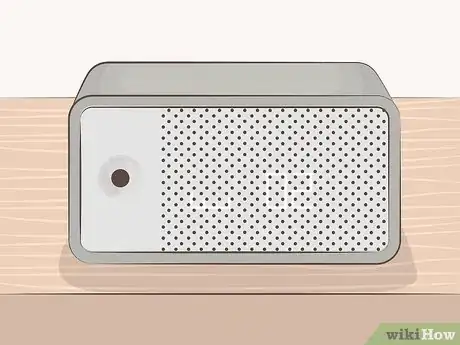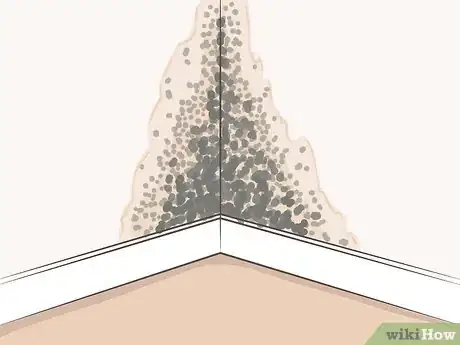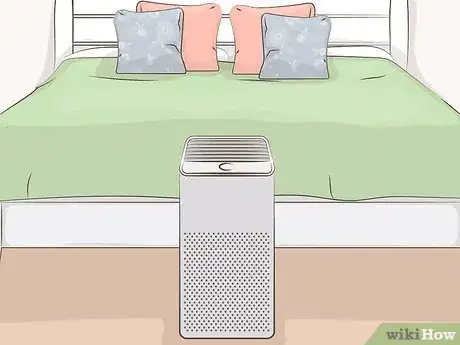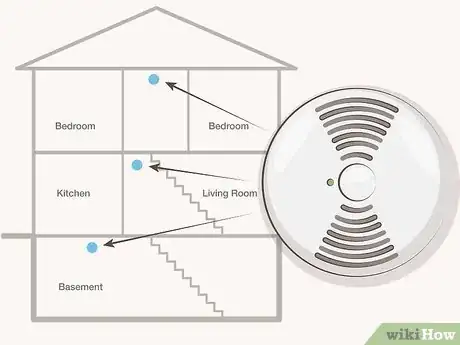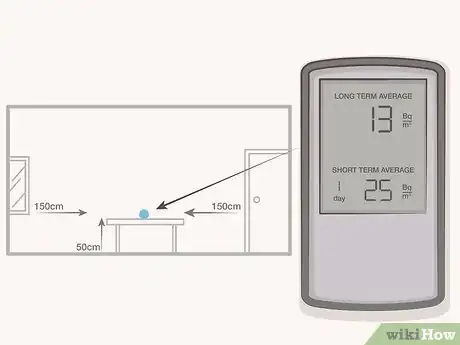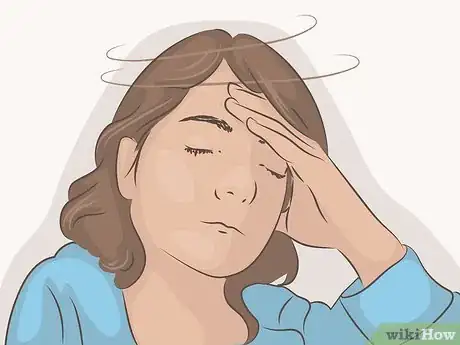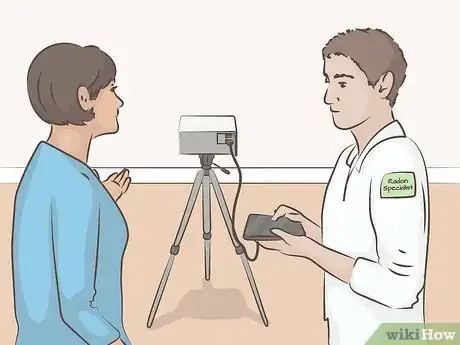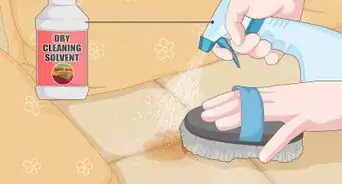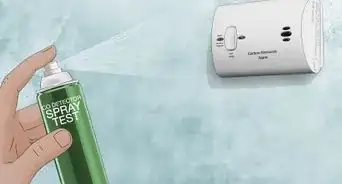This article was co-authored by Victor Belavus. Victor Belavus is an Air Conditioning Specialist and the Owner of 212 HVAC, an air condition repair and installation company based in Brooklyn, New York. In addition to HVAC and air conditioning units, Victor also specializes in furnace repair and air duct cleaning. He has over 10 years of experience working with HVAC systems.
There are 14 references cited in this article, which can be found at the bottom of the page.
wikiHow marks an article as reader-approved once it receives enough positive feedback. In this case, 90% of readers who voted found the article helpful, earning it our reader-approved status.
This article has been viewed 353,881 times.
We all want to breathe fresh, clean air, especially in our own homes. Testing the air quality in your home is a great way to make sure you’re not dealing with any problems, like mold, allergens, or radon. We’ve put together a list of different ways you can test your home’s air quality yourself as well as some tips on how to recognize symptoms of poor air quality. In case you encounter any issues, we’ve also included advice on how to hire a professional.
Steps
Doing Air Quality Tests Yourself
-
1Purchase an air quality monitor. There are currently quite a few indoor air quality monitors on the market that can effectively detect (and log over time) the quality of air inside your home. These devices typically check PM2.5 levels (tiny dust particles and other allergens in the air that you inhale), VOCs (Volatile Organic Compounds – like chemical pollutants), temperature, and humidity (for mold).[1]
- Some of the most reliable air quality monitors on the market are the Foobot, Awair, Speck, and Air Mentor 6 in 1.
- These devices typically cost between $150-$250 US.
-
2Check for signs and symptoms of mold. You can typically tell if there is a mold infestation in your home by using your eyes and your nose. If you smell a musty odor coming from certain parts of your home, and a cleaning doesn't remove the smell, you might want to consider hiring a professional for a mold test.[2]
- Mold thrives in moist areas like basements and dirty ductwork or drains.[3]
- You should also look around for visible signs of mold – like growing black spots, water sports, or particularly damp areas in your home.
Advertisement -
3Use an air purifier. These machines can be very useful in improving the air quality in your home, especially for those who suffer from allergy problems. Electronic air purifiers/air cleaners are typically the most effective, as they can remove dust particles, mold spores, and other allergens from the air more efficiently than filtered purifiers.
- Place the air purifier in your bedroom for the best results. This will most likely give you a longer period of exposure to the benefits of the machine (while you're sleeping) than in any other location in your house.
-
4Install carbon monoxide detectors on every floor of your home. Carbon monoxide is an odorless, colorless, tasteless gas that can be a byproduct of many appliances found in your home (like stoves, fireplaces, furnaces, water heaters, and grills). It can be deadly if inhaled, so it's important to always have carbon monoxide detectors installed on every floor of your home to alert you if there are high levels of CO in your home.[4]
- Place the carbon monoxide detectors close to your bedrooms so that you'll be more likely to hear the alarm when you are sleeping.
- Make sure you change the detector batteries regularly. A good rule of thumb is to change the batteries once every 6 months or so, though the duration will vary depending on the model.
-
5Perform an at-home radon test. Radon is a radioactive gas that occurs naturally as uranium breaks down. It can be found in the soil and well water, and sometimes it can infiltrate people's homes. The only way to prevent radon contamination is to test for it. You can purchase at-home radon tests from most home improvement stores.[5]
- Most tests involve a charcoal reading that is done by leaving the sensor material in your home, then collecting it after a given amount of time, and mailing the testing materials to a lab for analysis.
- Additionally, the National Radon Program Services at Kansas State University offers discounted test kits that you can purchase online at http://sosradon.org/test-kits.
-
6Change the air filters every few months. When in doubt, it's always a good idea to change your air filters. You should change the air filters at least once every 90 days for the average family home.[6] However, if you suspect the air quality in your house is poor, you can change them more frequently.[7]
- If you have a dog or cat in the house, change the air filters every 60 days.
- If you (or others in your home) have allergies, you should change the air filters every 20-45 days.
- If you have a washable filter, vacuum it first to remove any big particles. Then, soak the filter for 15 minutes before rinsing it with water.[8]
Watching for Signs of Poor Air Quality
-
1Notice an increase in allergy symptoms. It's easy to attribute allergy sensitivities to the weather or season changes, but it can often be caused by irritants in the air in your home. If you notice a significant rise in your allergy symptoms, it might be time to test the air quality in your house. Some common allergy symptoms include:[9]
- Coughing
- Sneezing
- Watery eyes
- Nasal congestion
- Headaches
- Bloody noses
-
2Pay attention to any unusual or new health symptoms. You might think that getting sick is unrelated to the air quality in your home. Often, this is true, but certain contaminants (like asbestos, toxic mold, and other chemicals) can negatively impact your health. This is especially true if you seem to suffer from frequent bouts of pneumonia or bronchitis. Get your home's air quality tested if you notice any of the following symptoms:[10]
- Dizziness
- Nausea
- Rashes
- Fever
- Chills
- Fatigue
-
3Monitor any construction in your home and neighborhood. Home construction can impact the quality of air in your home. Whenever there is a renovation or new construction project, the air can be exposed to dust particles, chemicals, and other harmful materials that can collect in your HVAC system and then begin to circulate throughout the entire house.[11]
- Even construction done by neighbors can negatively impact the air quality of your home, so be sure to keep an eye out for that too.
- Some building materials, such as paints and paint strippers, can release VOCs (volatile organic compounds). These chemical fumes can cause unpleasant symptoms, like irritation in your eyes, nose, and throat, as well as more serious health problems, such as liver or kidney damage.[12]
Getting Professional Help
-
1Pay a professional to test the air quality in your home. If you suspect that the air quality in your home is poor, you should hire a professional who can test the air quality and give you an informed recommendation. Ask friends, realtors, or construction companies for referrals to a qualified specialist in your area. A professional will be able to test for poor air quality due to:[13]
- Indoor mold
- Lead-based paint
- Dust particles, dust mites, and other allergens
- Smoke-related air pollution
- Air fresheners, candles, and incense
- Household cleaners
- Combustion particles or gases
-
2Hire a radon specialist to test for radon in your home. If you suspect that you have significant levels of radon in your home, you'll need to hire a professional to resolve the issue. You can contact your state or local health department for a list of recommended professionals who can help clear the radon out of your home.[14]
- You can also use the Environmental Protection Agency's interactive map to find a qualified radon professional in your area.
-
3Use a professional test if you need an official test result. If you are buying or selling a home, often testing the air for pollutants is a contingency of the loan you will be applying for. This is especially true in regions that have high levels of air pollution due to industry or even natural causes (like the common occurrence of forest fires). In these cases, at-home tests that you complete yourself will not be sufficient.[15]
- Hire a professional who has experience testing air quality in homes, preferably one who is recommended by your realtor, lender, or home inspector.
- If you don't have a recommendation for a professional, try to do some online research by reading online reviews from actual customers of various professionals in your areas.
- You can also check a prospective professional for certifications in the field – such as membership in the Indoor Air Quality Association or the International Association of Certified Indoor Air Consultants.[16]
Expert Q&A
-
QuestionHow can I improve the air quality in my home?
 Victor BelavusVictor Belavus is an Air Conditioning Specialist and the Owner of 212 HVAC, an air condition repair and installation company based in Brooklyn, New York. In addition to HVAC and air conditioning units, Victor also specializes in furnace repair and air duct cleaning. He has over 10 years of experience working with HVAC systems.
Victor BelavusVictor Belavus is an Air Conditioning Specialist and the Owner of 212 HVAC, an air condition repair and installation company based in Brooklyn, New York. In addition to HVAC and air conditioning units, Victor also specializes in furnace repair and air duct cleaning. He has over 10 years of experience working with HVAC systems.
Air Conditioning Specialist First, change your air filters out every 3 months to keep pollutants from building up in the air. Then, get an air purifier. There are UV filters, HEPA filters, and ionic purifiers, all of which will improve the air quality in your home. You can also use a carbon-activated filter if your main issue is with lingering odors in your home.
First, change your air filters out every 3 months to keep pollutants from building up in the air. Then, get an air purifier. There are UV filters, HEPA filters, and ionic purifiers, all of which will improve the air quality in your home. You can also use a carbon-activated filter if your main issue is with lingering odors in your home. -
QuestionHow should I clean the filter on my air conditioner?
 Victor BelavusVictor Belavus is an Air Conditioning Specialist and the Owner of 212 HVAC, an air condition repair and installation company based in Brooklyn, New York. In addition to HVAC and air conditioning units, Victor also specializes in furnace repair and air duct cleaning. He has over 10 years of experience working with HVAC systems.
Victor BelavusVictor Belavus is an Air Conditioning Specialist and the Owner of 212 HVAC, an air condition repair and installation company based in Brooklyn, New York. In addition to HVAC and air conditioning units, Victor also specializes in furnace repair and air duct cleaning. He has over 10 years of experience working with HVAC systems.
Air Conditioning Specialist If you have a disposable filter, replace it at least every 3 months. If you have a washable filter, vacuum it to remove any large particles, then soak it for 15 minutes in a mixture of 30g citric acid and 1 liter water before rinsing it thoroughly.
If you have a disposable filter, replace it at least every 3 months. If you have a washable filter, vacuum it to remove any large particles, then soak it for 15 minutes in a mixture of 30g citric acid and 1 liter water before rinsing it thoroughly.
Warnings
- Secondhand smoke from tobacco products can have a major negative impact on the air quality in your home. If you or someone else in your home smokes, consider doing it outdoors only and asking others to do the same.[17]⧼thumbs_response⧽
References
- ↑ http://energysmartohio.com/indoor-air-quality/which-indoor-air-quality-monitors-are-best-and-why/
- ↑ https://moldblogger.com/mold-warning-signs-how-to-tell-if-you-have-a-mold-problem/
- ↑ Victor Belavus. Air Conditioning Specialist. Expert Interview. 1 April 2020.
- ↑ https://www.safety.com/carbon-monoxide-detector-placement/#gref
- ↑ https://www.epa.gov/radon/find-radon-test-kit-or-measurement-and-mitigation-professional
- ↑ Victor Belavus. Air Conditioning Specialist. Expert Interview. 1 April 2020.
- ↑ https://www.serviceexperts.com/faq/how-often-should-i-change-my-air-filter-at-home
- ↑ Victor Belavus. Air Conditioning Specialist. Expert Interview. 1 April 2020.
- ↑ https://learn.allergyandair.com/checking-indoor-air-quality/
- ↑ https://learn.allergyandair.com/checking-indoor-air-quality/
- ↑ https://www.epa.gov/indoor-air-quality-iaq/improving-indoor-air-quality
- ↑ https://www.epa.gov/indoor-air-quality-iaq/volatile-organic-compounds-impact-indoor-air-quality
- ↑ https://www.consumerreports.org/cro/magazine/2012/06/is-poor-indoor-air-quality-making-you-sick/index.htm
- ↑ https://www.cpsc.gov/Safety-Education/Safety-Guides/Home/The-Inside-Story-A-Guide-to-Indoor-Air-Quality
- ↑ http://www.greenhomeguide.com/askapro/question/what-tests-can-i-do-myself-to-check-how-healthy-my-home-is
- ↑ https://iac2.org/
- ↑ https://www.epa.gov/indoor-air-quality-iaq/care-your-air-guide-indoor-air-quality
About This Article
Poor air quality in your home can cause allergies, asthma, and other health problems. You can monitor your indoor air quality using an air quality monitor. It will check your air for particulate matter like dust and allergens, as well as chemical pollutants like volatile organic compounds. An air quality monitor will check humidity and temperature levels too. You should also install carbon monoxide detectors on every floor of your home so you’re alerted to any leaks. You can also use an at-home radon test to check your home for radon contamination. If you’re experiencing symptoms of poor air quality, like allergies, dizziness, rashes, fever, or fatigue, call a professional to test the air quality in your home. They’ll be able to do more accurate tests and give you an informed recommendation. To learn more, including how to hire a professional to test the air quality in your home, read on.
